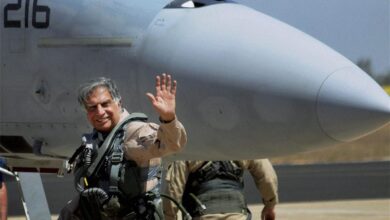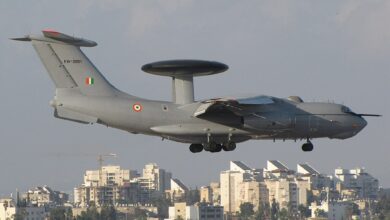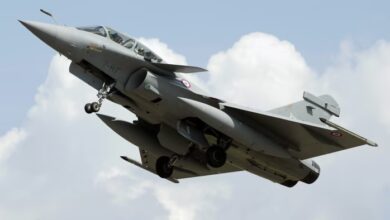India’s Response to China’s J-16D Electronic Warfare Aircraft – For Next-Gen War, IAF Fighters Set to Get ‘Made in India’ Electronic Warfare Suite

- Modern EW systems will greatly increase the battle-survivability of IAF fighter aircraft while flying operational missions against opponents' ground-based and airborne fire control and surveillance radars.
- The Defence Research and Development Organisation conceived and developed the EW suite in-house (DRDO). According to Ministry officials, the project embodies the spirit of Atmanirbhar Bharat and will contribute in the achievement of the road to self-sufficiency.
The Ministry of Defense and Bharat Electronics Limited (BEL), an industrial partner, recently signed an agreement to supply the Indian Air Force with an advanced Electronic Warfare suite for its fighter aircraft. The overall cost of the contract is estimated to be around Rs 1993 crores (approximately $26.5 million).
Modern EW systems will greatly increase the battle-survivability of IAF fighter aircraft while flying operational missions against opponents’ ground-based and airborne fire control and surveillance radars.
After the 2019 battle between the Indian Air Force and Pakistani pilots in the aftermath of the Balakot strikes, as well as the standoff with China in the Eastern Ladakh region, where both sides had mobilised their respective combat aircraft, the IAF’s EW suite contract becomes relevant.
The Defence Research and Development Organisation conceived and developed the EW suite in-house (DRDO). According to Ministry officials, the project embodies the spirit of Atmanirbhar Bharat and will contribute in the achievement of the road to self-sufficiency.
According to The New Indian Express, the BEL would develop the Instrumented Electronic Warfare Range (IEWR) EW equipment at a cost of Rs 1109 crores. According to the Ministry of Defense, the IEWR would be used to test and appraise airborne electronic warfare (EW) equipment as well as certify their deployment in an operational context.
The Defence Research and Development Organisation (DRDO) is India’s principal defence development agency, having previously produced the Indian Navy’s ‘Shakti’ EW system. It was handed over to the Indian Navy’s Capital Warships in November last year for the interception, detection, classification, identification, and jamming of traditional and modern radars.
The first Shakti system was placed on the INS Visakhapatnam, and is now being installed on the INS Vikrant, India’s indigenous aircraft carrier, which is expected to be operational later this year.
The DRDO also created the ‘Uttam’ AESA radar to help Electronic Warfare operations, making India one of the few countries with an indigenous electronic warfare force multiplier. The Indian AESA radar is 95 percent indigenous, with only one foreign subsystem.
The Indian home-grown AESA radar ‘Uttam’ was showcased by the DRDO at India’s Republic Day parade this year, with the potential to track 50 targets in the sky across a distance of more than 100 kilometres and engage four of them at the same time. The LCA Tejas aircraft are expected to be equipped with this radar.
Electronic Warfare (EW)
In today’s intensely contested battlespace, a robust electronic warfare capability is essential. The Indian Air Force will benefit from modern EW technology that gives pilots a leg up on the competition.
The purpose of EW is to deny the opponent unlimited access to the electromagnetic spectrum while allowing friendly access. When US Air Force bombers were equipped with jammer pods to reduce losses from surface-to-air missiles in Vietnam, EW proved important.
Moreover, during the Gulf War, the Israeli Air Force proved how integrated air defences were vulnerable to a mix of EW and SEAD/DEAD aircraft in Operation Mole Cricket 19.
The J-16D aircraft is used by India’s main enemy over the border. The J-16D is an electronic warfare derivative of the J-16 fighter jet created by China. It has been modified to improve precision capability and operational manoeuvre on the axis of information and communication, culminating in the installation of a blanket aviation electronic system.
It’s a twin-seat multi-role aircraft with EW pods located beneath the fuselage. Its mission includes electronic reconnaissance, communication, and radar jamming.
It can elude hostile radar systems and undertake seamless monitoring and deception thanks to the EW pods. Air-to-air missiles are also installed on the J-16, allowing it to engage in both conventional and electronic warfare.
The EA-18 Growler electronic warfare aircraft, on the other hand, is owned by the United States. The Growler is an F/A-18 Super Hornet variant that will be stationed in Germany to strengthen NATO’s eastern flank as it fights a war in Ukraine.
The aircraft was created to counter enemy electronic warfare systems by providing tactical jamming capabilities as well as land and naval protection. This is accomplished by two Northrop Grumman ALQ-218(V)2 wingtip pods equipped with a wideband receiver and selective reactive jamming capability.
Despite the fact that the EA-18 Growler’s EW suite is secret, the wingtip pods displayed on the aircraft are part of the aircraft’s internal AN/ALQ-218 system. One comprehensive solution includes a radar warning receiver, electronic support measures, and electronic intelligence functions.
Because of these characteristics, the Growler can identify, describe, and geo-locate hostile radars. It would also aid in the acquisition of information on enemy transmissions. The US Navy is reportedly considering enhanced EW pods for the EA-18G Growler as part of its Next Generation Jammer programme.
Electronic warfare systems are used by sophisticated forces all over the world since modern battles rely on information packages. In a dynamic regional security architecture, the Indian Air Force’s operational and combat capacity might be expected to rise dramatically with the acquisition of its own EW system.







Facebook Comments